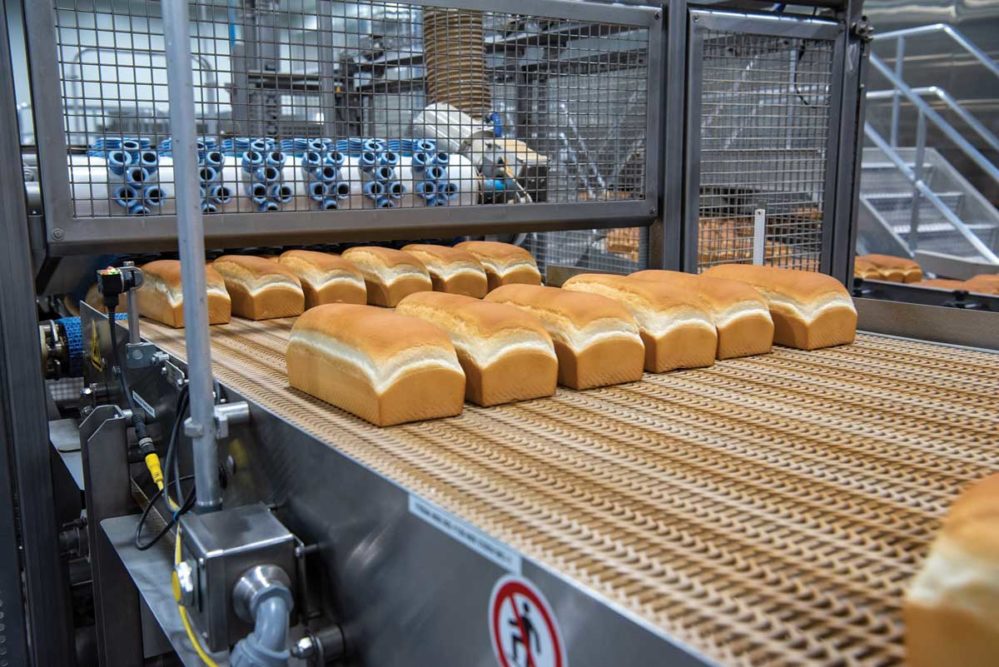Listen to this article:
Front to back, it takes roughly 2.5 hours to create a loaf of Kwik Trip bread or pack of buns. And it took a lot of dialing in to perfect every minute of that process for the 19 total SKUs produced in the company’s new 200,000-square-foot baking facility in La Crosse, Wis.
The control centers on AMF’s Allen-Bradley touchscreen HMI for each side allow operators to see the progress of each operation and easily tweak as needed, whether in the AMF proof box, BakeTech oven or AMF cooling tower.
A Burford Corp. seeder/splitter on each side executes splits for Kwik Trip’s submarine buns and French rolls on the bun side and tops the 8-grain bread before baking on the bread side.
After bread and buns are removed via Capway depanners and the bun pans head through a Henry Group cleaning system, an EyePro System ensures that products are in spec and kicks rejected product off the line. This also allows operators to make any adjustments to the bake.
In addition to quality control, food safety is of the utmost importance, which is why both sides include Fortress Technologies metal detection at three points in the process: makeup, post bake and packaging.
Perhaps the most critical aspect the bakery needed to dial in was packaging. When the technology upstream is kicking out that much product that fast, there’s risk of bottlenecks at the end of the line. To avoid this, Kwik Trip placed a heavy emphasis on how it set up the packaging department, which includes five AMF bread slicers, five UBE baggers each for bread and buns, two AMF bulk baggers and a Bosch individual bagger for hot dog buns, followed by Burford Corp. bread and bun tiers.
“We spent a lot of time and effort to make sure each individual line is getting product, and we’re not starving one and flooding another,” explained Eric Fonstad, director of operations for the bread and bun bakery.
The bakery built in plenty of redundancy, so if one packaging line goes down, it can fire up another.
Once products are bagged and tied, an AMF robotic Versaloader loads bags into trays before they head over to the warehouse, which takes up more than one-third of the plant’s square footage. In this 87,000-square-foot space lives a metropolis filled with somewhere in the neighborhood of 80,000 trays stacked in towers up to 20 high. They’re managed by a Cimcorp order pulling system, the likes of which is almost unseen in the baking industry.
The system manages the inbound and outbound items with six gantries that are zoned inside three cells. Once trays are stacked, product data leaves the AMF data control.
“We transfer that data into Cimcorp,” said Bruce Burmeister, bakery production manager. “Cimcorp will take trays and upstack them to 20 high, and the system knows where to pick a spot on the outbound side to place them. When the orders come in from the store, it will pull those orders by store and route.”
The system can grab a single tray or pull all 20 at once.
“It’s like a sleeve over the trays,” Mr. Fonstad said. “It clamps onto them, picks them up, and off it goes.”
Inventory is held no more than a day and a half before it’s transferred to the distribution center and loaded onto route trucks for delivery to all 700 stores. To keep up with that, the gantries move at 22 mph picking and placing product. To ensure coworker safety, the cells are blocked off by fencing, and the system comes to a stop if anyone crosses inside.
Before, this was all done manually, but skyrocket growth made the sheer ergonomics a challenge for human hands. Kwik Trip discovered the Cimcorp system in the dairy industry and is aware of just one other bakery operation using this system.
“This was an enormous job, and there weren’t a lot of options out there,” Mr. Burmeister said. “Just imagine what it would take to manage this many trays by hand.”
In Kwik Trip’s latest bakery plant, 200,000 square feet is a lot of ground to cover, especially when going through a tanker-load of flour a day.
But thanks to technology upgrades that include more than 2,000 interconnected pieces to control the bakery’s MES, maintenance, SCADA systems, ingredient handling system, order pulling, and energy management system, coworkers have a bevy of paperless and wireless resources to know where every product is at any given stage of the operation.
For example, flat-screen monitors are placed throughout the bakery floor noting the status of production.
“If there’s an issue in one part of the bakery or an alarm sounds, coworkers can see on monitors what’s going on from another area,” said Eric Fonstad, director of operations for the bread and bun bakery.
This makes different points of the process easy to monitor without coworkers planting their feet just waiting for something to go wrong.
“It’s very helpful,” he observed.
And the use of tablets made quality control completely paperless, which has not only improved accuracy over hand-written records, but it also makes FSMA compliance much easier.
“When the state of Wisconsin comes in, and they see we do this, it’s a lot easier,” Mr. Fonstad said. “If they say, ‘Show us an example of a run from two weeks ago where you have all your information,’ we can readily hand it to them.”
This article is an excerpt from the February 2020 issue of Baking & Snack. To read the entire feature on Kwik Trip, click here.






